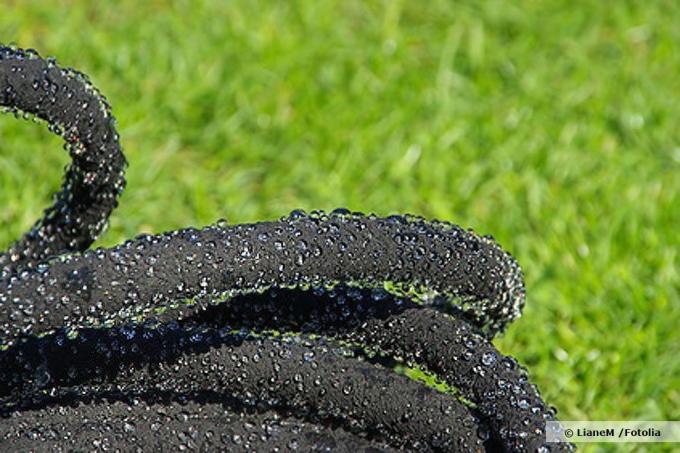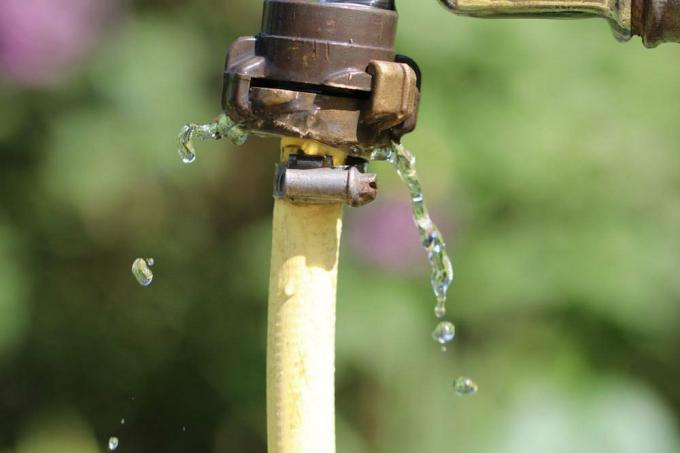
table of contents
- Soaking hose, drip hose and spray hose
- Soaking tubing and dripping tubing
- Advantages and disadvantages
- Laying and pouring times
- Spray hose
- Advantages and disadvantages
Watering the garden is often a much debated topic. Because garden irrigation should not only be easy and convenient, but also environmentally friendly, water and therefore cost-saving. Watering cans and garden hoses are not always the best solutions. An alternative form of irrigation are pearl, drip or spray hoses. But here, too, it is important to weigh the advantages and disadvantages.
Soaking hose, drip hose and spray hose
Since the names of these irrigation systems sound very similar, the question arises whether there is a difference between these hoses. This is not as easy to answer as it initially seems, since the differences, as is so often the case, are in the details.
Soaking tubing and dripping tubing
A bead hose, like the drip hose, irrigates the garden with small water droplets that are continuously released. The difference, if any, is that in the case of the drip hose, the water droplets appear individually, at greater intervals, be dispensed, and with the bubble tube several drops at once, if you will, so not individually will. The bead hose looks almost like a ramshackle garden hose. This is due to the fact that the pearl tube has many small "pores" from which the water exits. So it drips much finer than the drip hose. Since it is a bit tedious to differentiate between individual drops and several drops, these two forms of irrigation are offered in stores for more or less identical products. Since some manufacturers do not even make this difference, the terms are often used synonymously.

Advantages and disadvantages
The biggest advantage of this form of irrigation is that the water can be applied continuously and in small portions. And this is good for the plants, because they can absorb small doses better than a gush of water from a watering can. The advantages at a glance:
- Young plants do not break off like under a hard jet of water
- saves water as continuous irrigation keeps the soil evenly moist and does not allow soil to dry out
- Water does not flow into deep layers of the earth first, especially in dry soils
So you can use a drip or Bead hose save up to 70 percent of irrigation water if the hose is laid correctly and is "poured" at the right times.
Laying and pouring times
The mentioned advantages for plants and wallet can only be achieved if you water at the right time, i.e. keep water evaporation as low as possible. Therefore, you should only turn on the tap when the sun is not shining or when the sun is shining. the temperatures, especially in summer, have not yet reached their peak during the day. This is the case at dusk and dawn when the ground is still cold. If the floor has already warmed up, you must expect that some of the water will evaporate on the warm floor, which in turn leads to increased water consumption.
tip: You can set the appropriate times with a timer.
The second point that is essential in order to take advantage of the bead hose is how to lay the hose correctly. A distinction must be made between above-ground and underground installation, each with a front or Disadvantages associated.

Above-ground laying
The above-ground laying of the hoses is primarily a visual question, because many hobby gardeners simply find the hoses laid simply not exactly pretty. You can remedy this by placing the drip tube under a Mulch layer embarrassed. If dark, i.e. brown to black, hoses are used for the garden bed, then they almost completely disappear from view. The hoses “disappear” in the garden bed when the plants have reached a certain size, ie cover the hose.
tip: Green hoses have the same effect on green spaces.
Underground installation
If the drip hose is laid underground, then logically you will not see it. However, this visual advantage can also hide a major disadvantage, namely the clogging of the hose. This is why you should use a bubble tube
- Soils with a very fine structure
- calcareous soils
do not lay underground, because lime and fine earth clog the drip hose and you have to dig it out of the 10 to 40 centimeter deep furrow to clean it.
Spray hose
There is a greater difference between the spray hose and the drip or spray hose. Determine the bubble tube. On the one hand, it is used by many manufacturers under the generic term "lawn sprinkler" or "Lawn sprinklers" are offered, the water is also given off to others in a different form. This is because it is sprayed several centimeters into the air from the openings in the hose, while the drip and soaking hose releases the water directly into the ground.
Advantages and disadvantages
A spray hose is particularly suitable for lawns and low plantings. But they can also be used for larger perennials or shrubs. The use of a spray hose is not recommended for large-leaved plants, as the sprayed droplets can leave limescale marks on the leaves. There are also spray hoses above ground relocated, which can lead to visual impairments in the garden.
The advantages of a spray hose are particularly evident in places in the garden that are difficult to access. Because in this way these plants are also supplied with sufficient water. They are also a valuable water dispenser for rock gardens or border beds. For the race the rule is that a “spray unit” should last at least half an hour. As with soaking tubs and drip tubes, you should only turn the tap on in the morning or morning. Turn up the evening hours, otherwise too much water will evaporate or evaporates.




